The Way It Is/ A special Christmas treat, Brian Redman and the Unsers' favorite carsby Gordon Kirby |
 In this Christmas week I'm concluding my series of columns about great drivers and their favorite cars with Brian Redman and the Unsers, Bobby, Al and Al Jr. We begin with Redman who enjoyed a long career racing a wide variety of sports cars as well as Formula 1 and F5000 cars. As a factory Porsche and Ferrari driver Redman won many long distance sports car races in the sixties and seventies and was a three-time US Formula 5000 champion in the mid-seventies with Carl Haas and Jim Hall's team as well as IMSA's first GTP champion in 1980.
In this Christmas week I'm concluding my series of columns about great drivers and their favorite cars with Brian Redman and the Unsers, Bobby, Al and Al Jr. We begin with Redman who enjoyed a long career racing a wide variety of sports cars as well as Formula 1 and F5000 cars. As a factory Porsche and Ferrari driver Redman won many long distance sports car races in the sixties and seventies and was a three-time US Formula 5000 champion in the mid-seventies with Carl Haas and Jim Hall's team as well as IMSA's first GTP champion in 1980.
"I'm one of those guys who's had the good fortune to drive many great racing cars in my career and it's hard to choose any one car," Brian begins. "My favorites include the Chevron B16S two-liter sports car, the Porsche 908/3 long-distance car and 917/30K Can-Am car, the Lola T332 Formula 5000 car, the Ferrari 312PB sports/racer and the remarkable BMW 3.5 CSL touring car. "Early in my career I drove a number of Derek Bennett's beautiful little sports cars, including the B5 and B8 models. In 1969 I raced the new Chevron B16 with a 1.6 liter Cosworth FVA F2 engine. We tested the car at Oulton Park and went to the Nurburgring and the car was absolutely dreadful. In the first practice session we were twenty-seven seconds slower than the fastest cars. 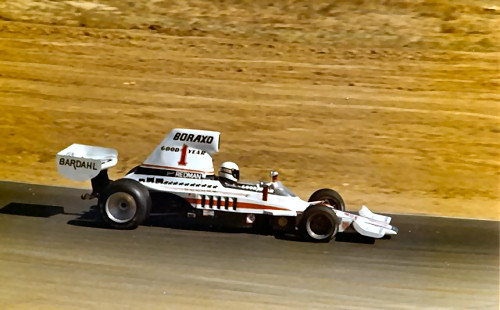 © Racemaker/Dennis Torres "In April of 1970 we went to the first race of the new European two-liter sports car championship at Paul Ricard. Jo Bonnier was there driving a factory Lola T210. It was an open cockpit car and weighed about 200 pounds less than the B16. We were lucky to win the race because Bonnier had an ignition problem and I told Derek Bennett that we had to have a spyder if we were going to beat Bonnier. "Derek said, 'No way.' He was building these B16 coupes and couldn't race a different car than he was selling. But by August he decided he would build an open cockpit, spyder version of the B16 but he said Chevron had no money for any aerodynamic research. At the time I was driving for Porsche in 908/3s and 917s, and I said to Derek, 'Don't worry about the aerodynamics. Just copy the Porsche 908/3.' "In September we went to the Nurburgring for the first race with the new Chevron spyder. It was a 500K race and we were leading by two and a half minutes when I came over a top gear jump halfway 'round the lap and when I landed the fuel pressure went to zero. So I switched on the electric pump and immediately there was a bang! A fuel line had fractured and it caught fire. "I kept driving for a few hundred yards to where there was a marshal's post and when I got there the car was ablaze. As I got out a large marshal wobbled off up the road but fortunately he left his fire extinguisher behind and I was able to put the fire out without completely destroying the car. "The next race was at Spa-Francorchamps, the fastest, most dangerous track in the world at that time. The crew at Chevron had done a tremendous job, completely rebuilding the car and we had a great race with Bonnier. We switched places every lap and were absolutely together all the way, but on the next to last lap I couldn't get first gear at the La Source hairpin and Bonnier pulled away by about 100 yards. "In 1969 I had set the fastest lap in the Spa 1,000Ks when Jo Siffert and I won in a long tail Porsche 908 that did 200 mph on the straight. Well, on the last lap in the Chevron I not only broke my track record with the Porsche but I went three seconds quicker! The Chevron only did 160 mph but its handling was fantastic. "I caught and passed Bonnier and we were on the climb back to the pits from Stavelot through a blind, flat-out right-hander and a blind, flat-out left-hander followed by La Source. To my horror I saw Bonnier coming past me on the uphill straight and as he pulled by he did what he always did which was to cut across in front of me and force me to brake. 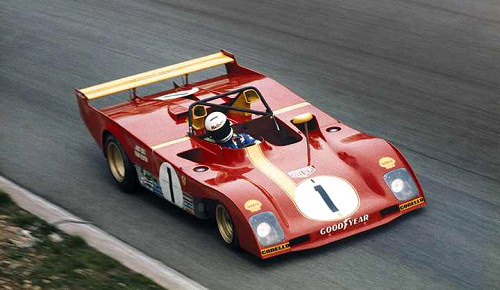 © LAT "In 1969 I also co-drove with Jo Siffert for Porsche in a 908/2 and we won five of the ten World Sports Car Championship races. We had a fantastic season and at the end of the year there was a massive celebration at Stuttgart. During that celebration we went to Weissach and the Porsche engineers asked me if I would like to see the new 908/3. They took me over into a darkened corner and took the dust cover off the first 908/3 and invited me to sit in it. It was amazing because there was nothing in front of your feet. "When I got out of the car the Porsche engineers asked me what I thought about their latest baby. I said I thought it was a very good car for Douglas Bader, the famous WWII fighter pilot who lost his legs in an accident before the war. From below your knees, your legs were ahead of the front wheels! There was nothing to protect you. "The 908/3 was built specifically for the Targa Florio and the Nurburgring and Jo and I won the Targa Florio with that car in 1970. It was a great little car and I still get to drive that car from time to time courtesy the Collier Museum in Florida who own it. It's unbelievable what that car can do with 370 horsepower and weighing only 1,100 pounds. It was an amazing car. Manfred Bantley was the engineer who designed that car and he never received the credit he deserves. "When John Wyer took over running the team I did most of the testing of the 917 with Kurt Ahrens. In testing at the Osterreichring, Wyer's team manager John Horsman realized it was the rear bodywork that was causing our problems. Until then we thought it was the chassis flexing and I know of five 917s and maybe more, that suffered a broken chassis. Always in the back of your mind with the 917K at places like Le Mans, Spa or Monza, there was the thought that if you hit something there was nothing to protect you. "Then the 917/10 Can-Am car came along in 1972 followed by the 917/30 in 1973. The 917/30 was light years ahead of the 917 and the 917/10. It was developed by Mark Donohue, Penske Racing and Porsche into an amazing car with which Donohue dominated the '73 Can-Am series. At the end of the year the SCCA put some fuel restrictions on the 917/30 and Penske and Porsche pulled out of the Can-Am, but in the spring of 1974 Roger Penske called and asked if I would like to drive the 917/30 in a Can-Am race at Mid-Ohio. "I went up to the Penske shop and went into Roger's immaculate office without any papers at all on his polished desk and he asked me if I was ready to drive the 917/30. I told him I'd do it for $5,000 and he said, 'Brian, you're the most reasonable racing driver I ever met.' "So we went to Mid-Ohio and I put the car on pole position and won the first race in the rain by conserving the tires. At the time, Jackie Oliver and George Follmer were dominating the Can-Am in their Shadow DN4s which were extremely good cars and in the main race they were right behind me. The race started in the wet but it looked like it would dry out and we ran the race on hand-grooved, slick tires. "The 917/30 was very powerful but it had a lot of throttle lag and about five laps into the race I got on the power too soon and got very sideways. As I sorted it out Oliver and Follmer passed me and I sat behind them and watched them race each other very hard. They disliked each other and you could see it in the way they raced. I watched them for a few laps and then Follmer tried an impossible pass on Oliver and hit him straight in the side. Oliver carried on, but Follmer was out. "I was able to stay with Jackie but the track had dried and the handling of the Porsche in the dry on grooved tires wasn't very good. It pushed like crazy and towards the end of the race I went off into the grass and almost hit the barrier. So we finished a disappointing second and that was the last time that car ran in a Can-Am race. It was a fantastic car, a great pleasure to drive. 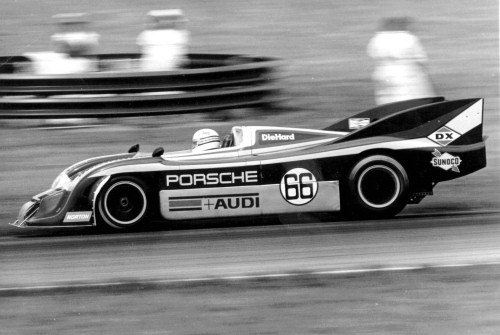 © Redman Collection "Then of course, there are the Lola T332 and T332C Formula 5000 cars in which I won three US F5000 championships driving for Jim Hall and Carl Haas in 1974, '75 and '76. That was just a fantastic car. The first version of it, the T300, was based on Lola's F2 car so it was small and light. The T332 came along a few years later and the T332C version was developed by Jim Hall at his Chaparral shop in Texas. It was a fantastic car to drive and at Watkins Glen and Mosport we were just as fast, even a little faster, than the F1 cars of those days. It was a great car and a lot of that was due to Jim Hall and the Chaparral people. "The BMW CSL was another fantastic car. We won the Daytona 24 hours in 1976 with that car and it was so good you wondered why anyone else bothered. At Daytona we went onto five cylinders about five in the morning and by driving it fairly hard and using the maximum revs of 9,000 rpm we were able to lap faster than the fastest RSR Porsches or Corvettes. That was a great handling car and the straight six engine winding up to 9,000 rpm was something to hear. "In 1980 I won the first IMSA GTP championship with the Lola T600 which was the forerunner of all the great GTP cars. It was a very good, straightforward car. It was a ground effect car and made lots of downforce and had plenty of horsepower from its Chevy engine. But in ten races we didn't have a single failure and much of that was due to John Bright who took care of that car and made it fantastically reliable." A three-time Indy 500 winner and two-time champion Bobby Unser chooses as his favorite car the factory AAR Eagle-Offy he drove in 1972 breaking records everywhere he went. "The '72 Eagle was a great car," Bobby grins. "We didn't win the Indy 500 that year but we broke every record there was with that car. It was the first car to run a 200 mph lap and we broke the track record at Indianapolis by 18 mph that year, the biggest jump in speed ever in the history of The Speedway. We had pole after pole after pole with that car. "Roman Slobodynskyj designed the '72 Eagle but a lot of it was Dan Gurney's ideas. Dan really understood the concept and we developed that car together. A lot of my ideas went into that car but Dan was at the top of his game in those days. All American Racers built some good cars through the late sixties and in the seventies. They were good cars, beautifully built, and the '72 Eagle was one of the most successful cars in my career. "The '72 Eagle was way ahead of its time and we had some tricks with the turbocharger that allowed us to make a lot of power. We learned how to make the power and the downforce too and it took everyone else a few years to figure out what we were doing. When Dan came up with the Gurney flap it turned that car from a good car into a great car. With the Gurney flap it just screamed for more horsepower. Give me more horsepower, it said. I can handle it. That car was bloody fast! "We developed and raced that car through four or five years and I finally won at the Speedway with Dan in 1975. For a few years everybody bought Eagles and one year I think there were 25 Eagles in the field at Indianapolis. 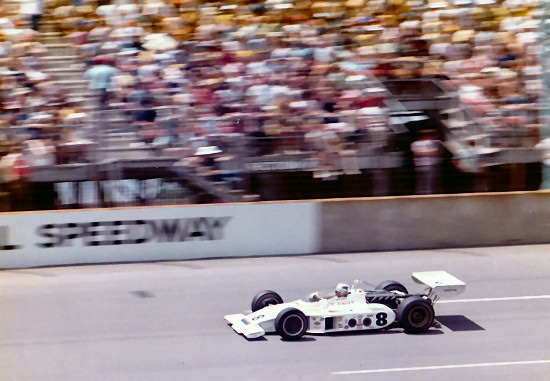 © Racemaker/Dennis Torres "The other car I was really proud of was Penske's '81 car. We sat on pole with that car at almost every race and without doubt won the Speedway. I don't care what Mario says. I outran him every lap and beat him on the racetrack and if I did pass some cars under the yellow--and what I did wasn't illegal--he passed almost as many cars under the yellow too. "So forget about the arguments and the politics. That was a good car and a fast car. It was good on the road circuits, on the big ovals and on the short ovals. It was just a good car. It was dominant like the '72 Eagle, but it just didn't have the advantage that the '72 Eagle had over the field. "I really enjoyed those three years with Penske from 1979-'81. I was hired by Roger to be the test driver and to develop the cars and I developed most of the underwings right here in my shop in Albuquerque. We had a great team and we made those cars go fast. They were really good cars. We didn't win many races in '81 but we led 'em all and should have won damn near all of them." Four-time Indy 500 winner and three-time champion Al Unser chooses as his favorite race car the Colt/Lola he drove to back-to-back Indy 500 wins in 1970 and '71. "I guess it has to be the Lola that Eric Broadley designed that I raced from 1968-'71," Big Al says. "At the end of 1968 George Bignotti made his own copy of the Lola for Vel's Parnelli Jones Racing and Bignotti made that car into a winner until it became obsolete in 1971. McLaren understood the rules better than we did and they just outdid us in 1971 with their new wedge-shaped M16 Indy car. "But in 1968, '69 and '70 that car was strong. It was the way to go and we won a lot of races and the championship in 1970. We won the Indy 500 in 1970 and I qualified on the pole and led all the way except for pitstops. We won again the following year but if Peter Revson had more experience on oval tracks he would have beat me with the new McLaren. "But until the McLaren came along that Lola was the best car out there. It looked good and it drove really well. You could make changes and feel it. That car was all aluminum and the monocoque was made from all one piece. That made it stiffer than most other cars. It didn't flex like most of them did in those days. 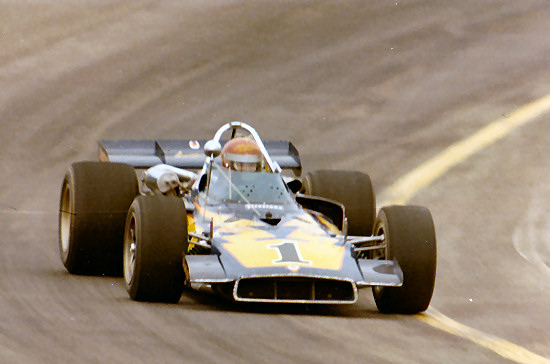 © Racemaker/Dennis Torres "Bignotti had that golden wrench. He made the right decisions and I could talk to him. He understood me and we won a lot of races. George would always say it was his idea, but I didn't care whose idea it was. All I cared was that I won. "Another favorite was the '86 March I won the 500 with in 1987. Nobody gave me a chance that year. I didn't even have a ride at the beginning of the month of May. I had five or six different offers to run that year but I turned them down because I didn't think they were capable of winning the race. I didn't want to just to take a ride. "Once you've learned how to win and know what it takes you can size a team up and I waited until the right offer came along from Penske. The only car he had available was a year-old March but I knew what the team was capable of and we started at the back of the field and came through to win. Things like that stand out in your racing life. "I made some mistakes over the years with the Alfa Romeo people in 1990 for example. They promised me everything but didn't deliver on any of it. I also made a mistake with the Porsche Indy car a few years earlier. I thought Porsche knew what they were doing, but they didn't when it came to designing and building an Indy car. "In 1978 we won the Indy 500 and the other two 500-mile races with another Lola, but that car was no good. We won because of Jim Hall's team. They made a bad car reliable and we got to the finish of all three 500-mile races and won 'em all. But that was because of the team. The car was so bad we hardly made the field for the 500-mile races but the team got us to the finish and won all three races for us. "You win because of the car and the team. It wasn't just me or anybody else. If you don't have everything put together, I don't care how good you think you are, you become junk overnight." 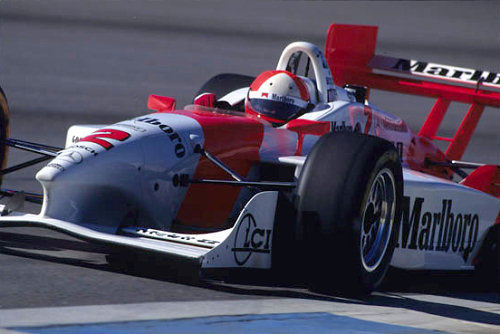 © Racemaker/Paul Webb "The one that stands out for me didn't win any races," Al remarks. "It's the Penske PC27 that John Travis designed. There was a PC27 in 1998 and a 27B in '99 and that would be my favorite race car. What made it my favorite was it had many fine features and was a beautiful car. It had a high nose and we were just getting into high noses in Indy cars at the time. Cosmetically, it was a really cool-looking car. "What I really liked it about it the most was it's transmission. When you were warming up the engine the oil went through the transmission casing and warmed up the gearbox at the same time you were warming up the engine. Also, the gear cluster was a direct drive from the crank so it wasn't reductive. The mass of the gear cluster was lower and it took me a while to learn how to shift it. "Once I learned how to do that it shifted like butter. You could use just two fingers on the shifter. It was a sequential shift, but all you needed was two fingers to go up and down, and I really liked that. It took a lot to get used to, but once you did, it was a real pleasure to drive. "When we first started testing that car the vanes in the transmission had holes in the inside. You would go out and make a lap and come in and oil would be pouring out. The first time it happened they couldn't find the leak. They cleaned everything up and I went out and made another lap and the same thing happened. That went on for about two weeks before they figured out the problem. Clive Howell told me it was like you took a water hose and put a bunch of little holes in the water hose. It would fill the inside of the gearbox with oil and then start puking out the oil. "Then they figured that the aluminum case heated up at a different rate than the gear cluster. So once I got to running it would start to jump out of gear because the clearances on the cluster weren't right. But once they got it all figured out it was a dream to drive. "The reason that car didn't win any races is because it had Goodyear tires and the little Ilmor/Mercedes engine. At the time Honda and Ford/Cosworth and Toyota were all going at it and they just blew us off. They had the power and Ilmor built a tiny little Mercedes-branded engine and we couldn't run with Honda and Cosworth. We were also one of the last teams to stay with Goodyear tires. Firestone had Goodyear beaten so bad it wasn't even funny. They just blew us away. 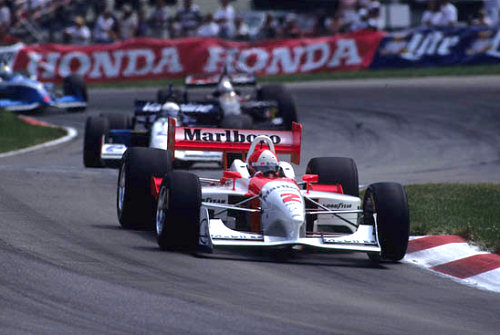 © Racemaker/Paul Webb "My second favorite car is the '94 Penske with the 209 cubic inch Mercedes single-cam engine--'The Beast'-- for that year's Indy 500. We surprised everybody and blew everyone away with that engine. We dominated and I was able to win my second Indy 500. "My third favorite car is the Galmer which Alan Mertens designed and I won my first Indy 500 with in 1992. And I also have to mention Al Holbert's Lowenbrau Porsche 956 and 962 IMSA GTP cars. I drove for Al's team for three years and we won the Daytona 24 Hours in 1986 and '87 with the 962. If I was to own a sports car for the street it would be a Porsche 962. It was a beautiful car and the only 200 mph race car I ever started with a key." I hope you've enjoyed the past five weeks' celebration of the adventurous and innovative spirit that drove motor racing throughout the 20th century. Like it or not, the new century has brought us a different kind of motor racing that seems to be here to stay. For better or worse, we live in a different age. Amid all these fine memories of the way the sport used to be the time has come for me to take my annual break from writing this column for a few weeks. My best to all for the holiday season and new year. I'll return on January 11th. |
|
Auto Racing ~ Gordon Kirby
Copyright ~ All Rights Reserved |
